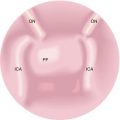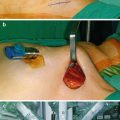Amiloride
Estrogen (combined oral contraceptive pill, hormone replacement therapy)
Diuretics
ACE inhibitors
Angiotensin II receptor blockers
Dihydropyridine calcium channel blockers
Heparin
Lithium
Nonsteroidal anti-inflammatory drugs (NSAIDs)
Plasma renin activity will typically be suppressed (<0.5 pmol/ml/h; normal 0.5–3.5) with a raised plasma aldosterone concentration >250 pmol/l. An ARR of >2,000 makes a diagnosis of Conn’s syndrome very likely.
Confirmatory tests:
These include the fludrocortisone suppression test and saline suppression test depending on local policy. Aldosterone fails to suppress in patients with primary hyperaldosteronism.
High-resolution CT of the adrenal glands is required in patients with biochemically confirmed primary hyperaldosteronism. This may show a unilateral hypodense adenoma, bilateral hyperplasia/nodularity, unilateral adrenal thickening, or normal appearances.
Other than in young (<40 years) patients with a typical presentation and confirmed (>1 cm) adenoma, all patients require lateralization of aldosterone secretion prior to surgery, principally because incidentalomas are common (4–7 % of the population), and there is a risk of misattributing the aldosterone excess to the adrenal adenoma.
Adrenal venous sampling for primary hyperaldosteronism:
Samples are collected from the left and right adrenal veins, inferior vena cava, and peripheral blood pre- and post-synacthen stimulation.
An aldosterone to cortisol ratio of one adrenal vein versus the other of >4:1 is indicative of unilateral secretion, whereas a ratio of <3:1 is indicative of bilateral secretion.
11C-metomidate PET-CT scanning may be a sensitive and specific noninvasive alternative to adrenal venous sampling for lateralizing aldosterone secretion by Conn’s adenomas, but is not widely available.
Testing for rare genetic causes (e.g., familial hyperaldosteronism type I or type II) may be necessary in certain circumstances (very early onset or family history of stroke or hypertension at a young age).
Medical Management
Aldosterone receptor antagonists, such as spironolactone and eplerenone, can be used.
Spironolactone can cause gynecomastia and reduced libido in men and menstrual disturbance in women.
Eplerenone has a lower affinity for sex hormone receptors, hence is a useful alternative to spironolactone for men who develop gynecomastia, but has marginally inferior antihypertensive effects.
Patients with Conn’s syndrome may have coexisting essential hypertension and often need other antihypertensive treatment even after successful surgery.
Pheochromocytoma/Paraganglioma
Presentation
Patients may be symptomatic or asymptomatic.
Typical symptoms include sweating (60–70 %), sustained or episodic hypertension (>90 %), and headache (90 %).
Other symptoms include pallor or flushing, palpitations, anxiety, panic attacks, and postural hypotension (due to decreased plasma volume).
The presentation depends on the predominant catecholamine secreted by the tumor together with the pattern of release. Noradrenaline-secreting tumors tend to cause sustained hypertension, whereas tumors secreting adrenaline and noradrenaline often cause episodic hypertension. Rarely, dopamine-secreting tumors can cause hypotension.
About 10 % of tumors are discovered incidentally on abdominal imaging undertaken for other reasons.
Clinical signs are usually absent.
Assessment
Assessment of blood pressure and cardiovascular status (including evidence of arrhythmias or left ventricular failure).
Check for evidence of hypercalcemia and glucose intolerance.
Screening for pheochromocytomas should be considered in:
Patients of a young age with hypertension
Patients with unexplained heart failure
Patients with classic episodic symptoms
Those with adrenal incidentalomas
Patients with a family history of von Hippel-Lindau (VHL) syndrome, multiple endocrine neoplasia (MEN) 2A or 2B, type 1 neurofibromatosis (NF1), or inherited paraganglioma syndrome (due to mutation in one of the succinate dehydrogenase (SDH) genes)
Diagnosis
Biochemical confirmation of elevated catecholamines and/or their metabolites is required.
Measurement of plasma or urinary metanephrines (99 and 97 % sensitive) and plasma or urinary catecholamines (86 and 84 % sensitive) have superseded urinary vanillylmandelic acid (72 % sensitive).
More than one measurement may be required because of intermittent tumor secretion.
False positive results can occur with sympathomimetics, phenoxybenzamine, tricyclic antidepressants, and other drugs (Table 1.2).
Table 1.2
Drugs known to increase catecholamine and metanephrine concentrations
Levodopa
Stay updated, free articles. Join our Telegram channel

Full access? Get Clinical Tree

 Get Clinical Tree app for offline access
Get Clinical Tree app for offline access



